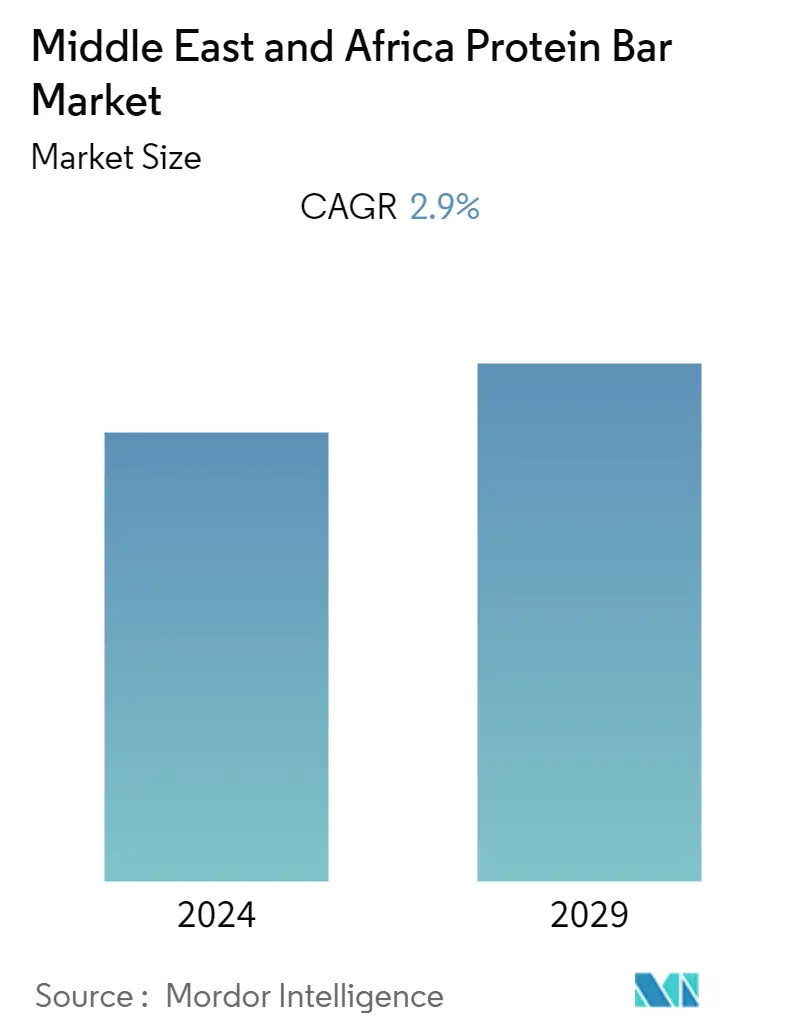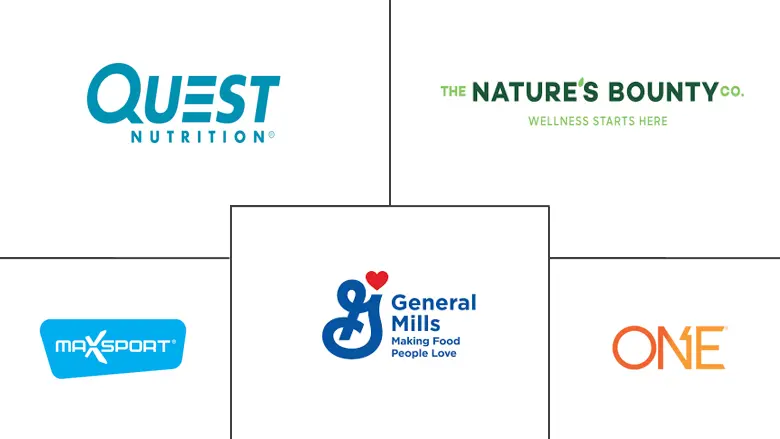Market Size of Middle East & Africa Protein Bar Industry

| Study Period | 2019 - 2029 |
| Base Year For Estimation | 2023 |
| Forecast Data Period | 2024 - 2029 |
| Historical Data Period | 2019 - 2022 |
| CAGR | 2.90 % |
| Market Concentration | Medium |
Major Players
*Disclaimer: Major Players sorted in no particular order |
MEA Protein Bar Market Analysis
The Middle-East and Africa protein bar market is expected to register a CAGR of 2.9% during the forecast period, 2020-2025.
- The increasing demand for convenience foods is driving the protein bar market. The major consumers not only include sports athletes, but also those who want to have a wholesome meal without the trouble of cooking. Consumers prefer buying protein bars for various purposes, such as weight management, improving muscle mass, and increasing energy.
- Moreover, marketing campaigns for protein bars as a substitute for meal replacement by the fitness clubs have skyrocketed the sales of these products. With an increasing number of health clubs and surging awareness about protein bars, the market is expected to witness a rise in demand during the forecast period.
- However, consumers' inclination toward other alternative protein-rich diets and high sugar content in the protein bars are the major factors restraining the market growth.
MEA Protein Bar Industry Segmentation
The Middle-East and African protein bar market is segmented by distribution channel into supermarkets/hypermarkets, convenience stores, specialist retail stores, online stores, and other distribution channels. Additionally, the study provides an analysis of the protein bar market in the emerging and established markets across the region, including South Africa, Saudi Arabia, and Rest of Middle-East and Africa.
| By Distribution Channel | |
| Supermarkets/Hypermarkets | |
| Convenience Stores | |
| Specialty Retail Stores | |
| Online Stores | |
| Other Distribution Channels |
| By Country | |
| South Africa | |
| Saudi Arabia | |
| Rest of Middle-East and Africa |
Middle East & Africa Protein Bar Market Size Summary
The Middle East and Africa protein bar market is experiencing growth driven by the increasing demand for convenience foods. This trend is fueled by a diverse consumer base that includes not only sports athletes but also individuals seeking easy meal solutions for weight management, muscle mass improvement, and energy enhancement. The market is further bolstered by marketing efforts positioning protein bars as meal replacements, particularly through fitness clubs, which have significantly boosted sales. Despite these positive trends, the market faces challenges from consumer preferences for alternative protein-rich diets and concerns over the high sugar content in protein bars.
The sports nutrition sector's expansion, alongside the rise in health club and gym participation, is a significant factor contributing to the market's growth in the region. Health centers and fitness clubs serve as key distribution channels, promoting protein bars and similar products. In South Africa, the market is supported by rising consumer awareness, increased disposable incomes, and product innovation, with a mature retail sector providing ample shelf space for protein bars. The youth demographic's demand for protein-based products, particularly for bodybuilding, further drives market growth. The competitive landscape is characterized by numerous regional and domestic players, with companies focusing on mergers, expansions, acquisitions, and strategic partnerships to enhance their market presence. Key players in the region include Quest Nutrition LLC, The Nature's Bounty Co., and General Mills Inc.
Middle East & Africa Protein Bar Market Size - Table of Contents
-
1. MARKET DYNAMICS
-
1.1 Market Drivers
-
1.2 Market Restraints
-
1.3 Porter's Five Forces Analysis
-
1.3.1 Threat of New Entrants
-
1.3.2 Bargaining Power of Buyers/Consumers
-
1.3.3 Bargaining Power of Suppliers
-
1.3.4 Threat of Substitute Products
-
1.3.5 Intensity of Competitive Rivalry
-
-
-
2. MARKET SEGMENTATION
-
2.1 By Distribution Channel
-
2.1.1 Supermarkets/Hypermarkets
-
2.1.2 Convenience Stores
-
2.1.3 Specialty Retail Stores
-
2.1.4 Online Stores
-
2.1.5 Other Distribution Channels
-
-
2.2 By Country
-
2.2.1 South Africa
-
2.2.2 Saudi Arabia
-
2.2.3 Rest of Middle-East and Africa
-
-
Middle East & Africa Protein Bar Market Size FAQs
What is the current Middle East & Africa Protein Bar Market size?
The Middle East & Africa Protein Bar Market is projected to register a CAGR of 2.9% during the forecast period (2024-2029)
Who are the key players in Middle East & Africa Protein Bar Market?
The Nature's Bounty Co., General Mills Inc., Barebells Functional Foods AB, Quest Nutrition LLC, Max Sport SRO and ONE Brands LLC are the major companies operating in the Middle East & Africa Protein Bar Market.

